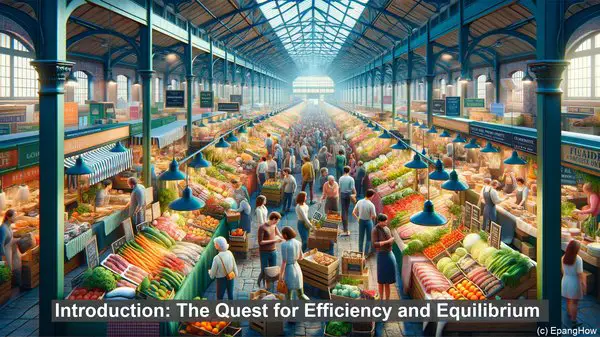Introduction: The Quest for Efficiency and Equilibrium
Hello everyone! Welcome to our exploration of Pareto efficiency and general equilibrium. In the realm of economics, these concepts play a pivotal role in understanding the optimal allocation of resources and the stability of markets. While both are concerned with efficiency, they approach the topic from different angles. So, let’s dive in!
Pareto Efficiency: The Pursuit of ‘No Better Off Without Making Someone Worse Off’
Pareto efficiency, named after the Italian economist Vilfredo Pareto, is a concept that revolves around the idea of an allocation where no individual can be made better off without making someone else worse off. In simpler terms, it’s a state where resources are distributed in such a way that no one can be made better off without harming another person’s well-being. This notion is often visualized through a ‘Pareto frontier,’ which represents the boundary of allocations where any reallocation would result in someone being worse off. Pareto efficiency is a crucial benchmark in welfare economics, as it signifies an allocation where no further improvements can be made without causing harm.
General Equilibrium: The Interplay of Supply, Demand, and Market Stability
In contrast to Pareto efficiency, general equilibrium focuses on the overall functioning and stability of markets. It delves into the intricate web of interactions between supply and demand across various goods and services. The concept of general equilibrium posits that for an economy to be in a state of equilibrium, not only should individual markets be in balance, but all markets should be in balance simultaneously. This means that the quantity supplied and the quantity demanded should be equal for every good and service in the economy. Achieving general equilibrium is a complex task, as changes in one market can have ripple effects on others. The study of general equilibrium often involves mathematical models and simulations to understand the dynamics of market interdependencies.

Applications: Real-World Relevance of Pareto Efficiency and General Equilibrium
The concepts of Pareto efficiency and general equilibrium have far-reaching implications in various domains. For instance, in public policy, Pareto efficiency is often used as a guiding principle to evaluate the impact of proposed interventions. A policy change that leads to a Pareto improvement, where at least one person is better off without harming others, is generally considered favorable. On the other hand, general equilibrium analysis helps in understanding the potential consequences of market disruptions or policy changes. By examining the interconnections between markets, economists can predict how changes in one sector can influence the overall economy. This understanding is crucial for policymakers and businesses alike, as it aids in making informed decisions and mitigating unintended consequences.

